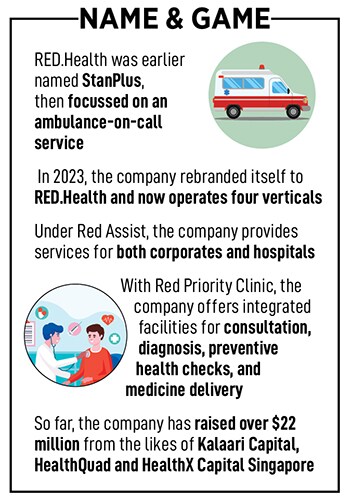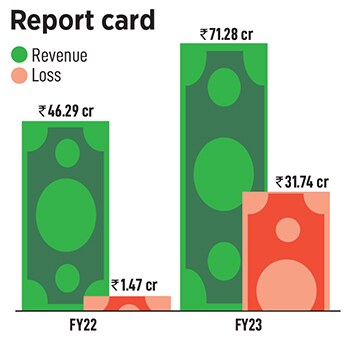
RED.Health: Providing medical assistance to corporate customers and the common man
By Manu Balachandran| Nov 29, 2023
Through its ambulances and skilled paramedics, RED.Health offers a comprehensive medical assistance platform and emergency care within minutes
 [CAPTION]Prabhdeep Singh, Founder, RED.Health
Image: Nishant Ratnakar for Forbes India[/CAPTION]
[CAPTION]Prabhdeep Singh, Founder, RED.Health
Image: Nishant Ratnakar for Forbes India[/CAPTION]
Prabhdeep Singh has a dream. To build a 911 for India.
It wasn’t quite how he started out. The 34-year-old had earlier built an Uber service for ambulances, StanPlus, that has now undergone a transition into RED.Health, to capitalise on the serious shortcomings in India’s emergency response infrastructure. RED.Health, Singh says, now offers a comprehensive medical assistance platform, providing everything from emergency response to recovery for both the corporate customer and common man.
_RSS_“It was always part of the journey,” Singh tells Forbes India. “We started as an ambulance company with a clear mandate that we are going to go to this place where we will be covering the entire gamut of emergency response.”
At the heart of it still, RED.Health, through its ambulances and skilled paramedics spread across some 550 cities in the country, wants to address the issue of bringing an ambulance as quickly as possible in case of an emergency. So far, the company has been able to do that within eight minutes. Within 0.8 seconds, Singh says, a customer’s call will be addressed upon calling the hotline. The company has a fleet of over 10,000 ambulances and has handled over 260,000 cases since it was launched. “We save a life a day,” Singh says.
But since its rebranding and pivot last year, the company has turned its attention to newer frontiers that include enterprise solutions for the corporate sector, a priority clinic, where it offers everything from integrated facilities for consultation, diagnosis, preventive health checks, to medicine delivery and a vertical that will train paramedics on emergency procedures such as CPR and AED (automated external defibrillators).
“In the US there is the 911 system,” Singh says. “What we are building is a full stack. We started as an ambulance company and we have graduated to being an extremely high-technology emergency system company that is integrating anyone who wants emergency solutions to be built out on their platform, premises, devices, application, cars, or in their wearables and their phones, end to end.”  Singh’s StanPlus shot to fame during Covid-19 when its ambulances plied across cities ferrying those in need. India currently has only 25,450 state-run ambulances with another 29,259 from the private sector. India also has only one ambulance per 125,000 people, in comparison to the US which has one ambulance per 1,000 people. Emergency cases account for up to 30 percent of all OPD patients in the country, while in terms of admissions, they account for up to 24 percent of government hospital patients and up to 39 percent in private hospitals, according to government think tank Niti Aayog.
Singh’s StanPlus shot to fame during Covid-19 when its ambulances plied across cities ferrying those in need. India currently has only 25,450 state-run ambulances with another 29,259 from the private sector. India also has only one ambulance per 125,000 people, in comparison to the US which has one ambulance per 1,000 people. Emergency cases account for up to 30 percent of all OPD patients in the country, while in terms of admissions, they account for up to 24 percent of government hospital patients and up to 39 percent in private hospitals, according to government think tank Niti Aayog.
Singh says even during the early days, the company was clear that it would go a long way in powering the emergency response ecosystem. The company has partnered with over 300 hospitals, raised over $20 million, and offers enterprise solutions in more than 30 cities across 80 enterprise sites, managing some 20,00,000 employees. Under the pivot into RED.Health, the company now has four verticals, including RED Ambulances, RED Assist, RED Priority Clinics, and RED Academy.
“In the next 10 years, machines are going to call machines in emergencies,” Singh says. “Most of the emergencies will become predictive or at the point of incidence, there will be a sensor that will be able to detect. When they call, we pick up the call, we understand what’s happened, we get all the contextual information, and the nearest hospital’s ambulance system is also operated by us.”
According to a report published by Niti Aayog, and the All India Institute of Medical Sciences (AIIMS), 98.5 percent of ambulances in India carry dead bodies, while 90 percent of ambulances are without any equipment or oxygen. Ninety-five percent of ambulances have untrained personnel while 30 percent of mortality is due to delays in emergency care.
Also read: How Exponent is building a sustainable EV infra startup
Starting from Trauma
Initially operating out of Andhra Pradesh and Telangana, StanPlus was the brainchild of three Insead graduates, Prabhdeep Singh, Antoine Poirson and Jose Leon. The company started by providing ambulances for those in distress within 15 minutes of a request; the vehicles are fitted with advanced and basic life support and cardiac care.The idea to start an ambulance service came from Singh and his co-founder’s personal experiences. Poirson was witness to his colleague passing away due to the inadequacies of the ambulance that was carrying him in Rajasthan. “Hospitals pay us and patients also pay us for our service,” Singh says about the company’s revenue model when it comes to the ambulance services. “So, the way the system works is that we get paid across the ecosystem.”
 While the company directly owns and operates 400 ambulances, the company has 10,000 ambulances under its fold through various tie-ups. “There’s a platform fee that they pay,” Singh says. “They get GPS and technology, and we train them. We are now standardising our response to under 20 minutes across cities,” he says, adding that the company is expanding operations across the country.
While the company directly owns and operates 400 ambulances, the company has 10,000 ambulances under its fold through various tie-ups. “There’s a platform fee that they pay,” Singh says. “They get GPS and technology, and we train them. We are now standardising our response to under 20 minutes across cities,” he says, adding that the company is expanding operations across the country. Earlier this year, the company also launched an air ambulance service (RED Air Guardian) with over 25 aircraft with the ambulances being equipped with state-of-the-art medical technology, clinical pathways, and a team of qualified critical care professionals.
“India is making progress in addressing the over-500,000 emergency cases through timely interventions each year,” Singh says. “Since the concept of EMS (emergency medical services) is fairly new, the biggest challenge for EMS has been infrastructure and manpower.”

“RED.Health is designed to solve for the highly unorganised market with its inherent inefficiencies and inconsistent quality of care during transportation that leads to poor response times and higher mortalities during transport,” Pinak Shrikhande, managing director at HealthQuad, a health care venture capital firm, says. “RED.Health leverages advanced algorithms to reduce the time to dispatch the appropriate vehicle depending on the condition of the patient. With a team of dedicated and trained paramedic staff which is in constant communication with the hospital teams, it leads to improved outcomes, especially during the golden hour.”
That means even as the company lays a steady focus on both emergency response and assistance segments, RED.Health is also turning all its attention towards the corporate sector, where it wants to work with the top 2,000 companies in India. The company is already assisting in setting up all the necessary emergency response mechanisms at workplaces and even facilitating help during an emergency through its various offerings.

That will be undertaken through its RED Assist vertical which comprises two segments, one for the hospital partners which includes centralised ambulance management and outsourcing (CAMO), and the other for corporates, which includes doctor-on-call and an online consultation service that links patients with doctors in real time. “You create training programmes and response programmes and build out a centralised system for employees to call,” Singh says. “So, it becomes completely seamless.”
They may have started as an ambulance service provider, but RED.Health has a clear opportunity when it comes to fixing the emergency care ecosystem in the country.